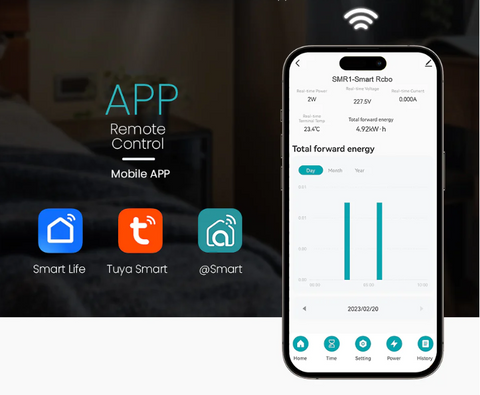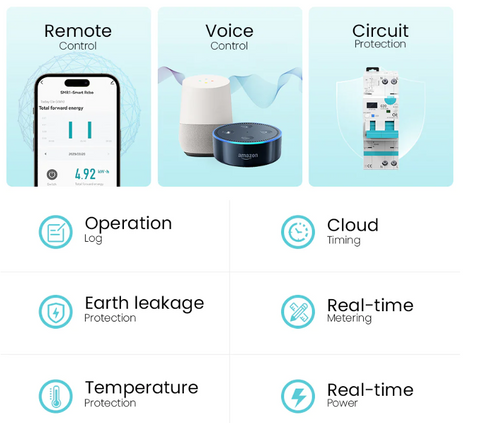3 Examples of the Best Smart Breaker in Action
I. Introduction
Smart breakers are an innovation in home technology that is changing how we interact with our electrical systems. These sophisticated devices replace traditional circuit breakers and offer a range of featuresthat enhance both convenience and safety. Electrical systems in homes are advancing with the inclusion of smart breaker technology, making them more efficient.
A. Brief Explanation of Smart Breakers
At their core, smart circuit breakers are advanced versions of the conventional circuit breakers found in electrical breaker panels. However, cutting-edge technology equips them to go beyond mere circuit protection. These intelligent devices are capable of real-time monitoring, remote control, and even communication with other smart home components.
B. Importance of Smart Breakers in Modern Homes
The modern household is a hub of technology, with an array of devices and appliances demanding power around the clock. Smart breakers on electric panels help homeowners control and understand their electricity usage as it increases.
These breakers are important for making homes safer by detecting problems before they become dangerous. Smart breakers ensure efficient and proactive safetyfor homeowners and their families, allowing them to confidently embrace the future.

II. Example 1: Energy Management
A. Monitoring and Controlling Power Consumption
A prominent characteristic of smart breakers is their capacity to track the power usage of separate circuits. Homeowners can monitor their electricity usage in real time with metering, which helps them make smarter decisions about energy consumption.
B. Adjusting Power Usage Remotely
Gone are the days of leaving home wondering if you've forgotten to turn off a power-hungry appliance. With smart breakers, you can remotely control your circuits using your smartphone or other connected devices. This level of control not only saves energy but also offers convenience that aligns perfectly with the demands of modern lifestyles.
C. Integration with Smart Home Systems
Smart breakers seamlessly integrate into larger smart home ecosystems, enabling coordination with other devices like thermostats, lighting, and security systems. For instance, during peak electricity rates, the breaker can communicate with your smart thermostat to adjust the HVAC system's energy consumption. This synchronization optimizes energy usage and saves you money.

III. Example 2: Safety Enhancement
A. Real-time Monitoring of Electrical Currents
Smart breakers constantly monitor the flow of electricity through circuits. This real-time monitoring allows them to detect irregularities and potential issues with appliances or wiring. Homeowners receive instant alerts if the system detects an abnormality, preventing potential hazards.
B. Immediate Detection of Faults or Abnormalities
Traditional circuit breakers provide protection through overcurrent detection, but smart breakers take safety a step further. These devices can detect small changes in current patterns. These changes may indicate a problem with the wiring. By detecting these changes, they can prevent dangerous situations from worsening such as short circuiting.
C. Automatic Shut-off in Case of Dangerous Situations
Smart breakers can automatically shut off the circuit when they detect a potentially hazardous situation. Taking quick action can prevent fires, shocks, and other risks, giving homeowners peace of mind when they're away.
Smart breakers with energy management and safety features are shaping the future of modern homes. Smart breakers are essential in modern homes because they offer real-time insights, remote control, and proactive safety measures. They are not just convenient but necessary for today and the future.
IV. Example 3: Customizable Settings
A. Tailoring Circuit Preferences for Different Devices
Smart breakers enable a level of customization that was previously unheard of with traditional circuit breakers. Homeowners can allocate specific circuits to different devices, and they can ensure that they distribute power optimally based on usage patterns. This customization not only prevents overloading but also maximizes energy efficiency.
B. Setting up Schedules for Appliances
With the ability to create schedules for individual circuits, smart breakers empower homeowners to automate the operation of appliances. Imagine your coffee maker turning on automatically every morning, or your water heater adjusting its usage based on your family's routines. These personalized schedules not only streamline daily tasks but also contribute to energy savings.
C. Adapting to Changing Power Needs
Modern households are dynamic, with power needs fluctuating throughout the day. Smart breakers recognize these changes and can dynamically allocate power based on demand. During times of heavy electricity use, like when cooking many meals at once, the breaker can control power to avoid tripping.
V. Comparison with Traditional Breakers

A. Advantages of Smart Breakers over Traditional Ones
Compared to their traditional counterparts, smart breakers offer several distinct advantages. They provide more comprehensive protection by actively monitoring electrical currents and detecting abnormalities beyond just overcurrent conditions. Additionally, their ability to shut off circuits automatically in hazardous situations adds an extra layer of safety.
B. Increased Efficiency and Convenience
Smart breakers revolutionize energy management by providing real-time data on energy consumption. This information empowers homeowners to make informed decisions about their usage patterns, ultimately leading to reduced energy bills. The convenience of remote control and scheduling adds to their efficiency, making everyday life more manageable and energy-efficient.
VI. Market Overview of Leading Smart Breaker Brands
A. Mention Top Manufacturers
Several prominent manufacturers are leading the way in the smart breaker industry. Names like Schneider Electric, AT-ELE, Eaton, and Leviton are at the forefront, driving innovation and setting the standards for quality.
B. Highlight Key Features of Their Products
Schneider Electric's smart breakers offer advanced energy monitoring and customizable scheduling, integrating seamlessly with their smart home ecosystem. AT-ELE focuses on monitoring and improving safety by detecting faults and automatically shutting off circuits when needed. Eaton's lineup boasts user-friendly interfaces, making it easy for homeowners to manage energy consumption and safety settings. Leviton's smart breakers excel in their integration capabilities, allowing seamless coordination with various smart home devices for a cohesive experience.
Leading brands are changing the electrical landscape with smart home solutions. These solutions give homeowners more control, safety, and energy efficiency.
VII. Real-life User Experiences
A. Testimonials from Homeowners Using Smart Breakers
John H.: "Smart breakers have transformed the way I manage my home's energy. Being able to see real-time usage data and set schedules has made a noticeable difference in my energy bills."
Sarah L.: "Safety was a top priority for me, and smart breakers have exceeded my expectations. The automatic shut-off feature gives me peace of mind, especially when I'm away from home."
B. Positive Impact on Energy Bills, Safety, and Convenience
Smart breakers have become a game-changer for homeowners. Users report significant reductions in their energy bills because of the insights gained from monitoring usage patterns. The integration of smart breakers with other devices has streamlined daily routines, enhancing convenience. Above all, the enhanced safety measures provided by these breakers have made homes more secure, preventing potential hazards.
VIII. Future Trends in Smart Breaker Technology
A. Predictions for Advancements in the Field
The future of smart breaker technology holds exciting possibilities. Enhanced AI algorithms will allow breakers to learn from usage patterns and provide even more accurate energy-saving recommendations. Predictive maintenance capabilities could prevent breakdowns and extend the lifespan of appliances. Additionally, improved wireless communication protocols will foster greater connectivity and interoperability.
B. Integration with Renewable Energy Sources
As the world shifts toward sustainable energy solutions, smart breakers will play a crucial role. These breakers will seamlessly integrate with renewable energy sources like solar panels and wind turbines. They will intelligently manage the flow of energy, ensuring efficient usage and optimal distribution throughout the household.
IX. Considerations Before Purchasing

A. Compatibility with Existing Electrical Systems
Before purchasing a smart breaker system, homeowners should ensure compatibility with their existing electrical setup. Some homes may require slight modifications to accommodate the new technology.
B. Installation Process and Requirements
Installing smart breakers may involve a more complex process compared to installing traditional breakers. Homeowners should consider hiring a licensed electrician for proper installation and setup to ensure safety and functionality.
C. Cost-Benefit Analysis
Smart breakers cost more initially but offer long-term benefits in energy savings, safety, and convenience that outweigh the upfront investment. Conducting a cost-benefit analysis will help homeowners make an informed decision.
X. Conclusion
Smart breakers are changing how we manage energy, improving safety, and making life easier in modern homes. From real-time monitoring to customized scheduling, these devices empower homeowners to take control of their electrical systems.
In the future, renewable energy and technology will make smart breakers more important for how we use our homes. Embracing this technology is not just a step forward; it's a leap into the future of smart and sustainable living.
Contact:
AT-ELE
sale@at-ele.com
www.at-ele.com



